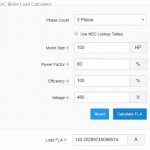Koosha_engX
Member
- Location
- California
Hi All,
So, myself and a friend have been working on a site, which will include various engineering calcs. Currently, the conductor / conduit sizing tool is up and running (there are two calculators, which can be toggled between from the top of the page). I would appreciate any feedback. You can check it out in the following link; keep in mind though, it's a work in progress: http://engcalc.herokuapp.com
Please review with the below points in mind; any and all constructive criticism is welcome.
1) How does the calculator work for you; does it help you with your work?
2) Is anything confusing that may need to be better explained / clarified (e.g. naming, user interface, etc.)?
3) What other feature would you like added into the flow (e.g. voltage drop)?
4) Is anything wrong / inaccurate?
5) Any other calculators that you're interested to have automated?
Again, your feedback will tremendously help. Thanks in advance.
Disclaimer: please don't use this tool right now for your work, as there still may be some issues that need to be ironed out.
So, myself and a friend have been working on a site, which will include various engineering calcs. Currently, the conductor / conduit sizing tool is up and running (there are two calculators, which can be toggled between from the top of the page). I would appreciate any feedback. You can check it out in the following link; keep in mind though, it's a work in progress: http://engcalc.herokuapp.com
Please review with the below points in mind; any and all constructive criticism is welcome.
1) How does the calculator work for you; does it help you with your work?
2) Is anything confusing that may need to be better explained / clarified (e.g. naming, user interface, etc.)?
3) What other feature would you like added into the flow (e.g. voltage drop)?
4) Is anything wrong / inaccurate?
5) Any other calculators that you're interested to have automated?
Again, your feedback will tremendously help. Thanks in advance.
Disclaimer: please don't use this tool right now for your work, as there still may be some issues that need to be ironed out.




